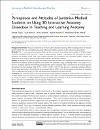Perceptions and Attitudes of Jordanian Medical Students on Using 3D Interactive Anatomy Dissection in Teaching and Learning Anatomy
| Author | Funjan, Khaled |
| Author | Ashour, Laith |
| Author | Salameh, Muna |
| Author | Mustafa, Ayman |
| Author | Seed Ahmed, Mohammed |
| Available date | 2023-09-18T04:43:09Z |
| Publication Date | 2023-01-01 |
| Publication Name | Advances in Medical Education and Practice |
| Identifier | http://dx.doi.org/10.2147/AMEP.S419333 |
| Citation | Funjan K, Ashour L, Salameh M, Mustafa A, Seed Ahmed M. Perceptions and Attitudes of Jordanian Medical Students on Using 3D Interactive Anatomy Dissection in Teaching and Learning Anatomy. Adv Med Educ Pract. 2023 Aug 3;14:837-844. doi: 10.2147/AMEP.S419333. |
| Abstract | Background and Aims: This study evaluates the use of virtual anatomy dissection (Anatomage Table) in teaching anatomy for Jordanian medical students. The study also highlights any gender differences in students’ perception on this method of teaching anatomy. Methods: This is a cross-sectional questionnaire-based study that was carried out on medical students enrolled in Al-Balqa Applied University, a Jordanian public university. A group of expert anatomists designed a questionnaire that investigates the students’ perceptions and attitudes toward using virtual anatomy dissection. The questionnaire also investigated student’s opinions and expectations on the impact of using this method on the academic achievement of students. Results: The findings of the study showed that most students agreed that Anatomage Table helped them better understand (64.3%) and memorize (64%) anatomy lectures. In addition, most students were interested in using this learning method in lab groups (72.3%). However, the didactic approach that combined anatomical models and the Anatomage Table was preferred over the unilateral approach that included only the Anatomage Table (80.5% vs 30.2%, p<0.001, r=0.9). Of note, there was a statistically significant difference between males and females in their preference for Anatomage Table (p<0.001), and in their perceptions on the impact of Anatomage Table on understanding of lectures (p<0.001) and memorization of anatomical structures (p=0.004). Conclusion: The Anatomage Table is a powerful teaching and learning method in undergraduate medical education. Its application to Al-Balqa Applied University has proven to be effective so far. It can be used to overcome the problems facing anatomical education in the college of medicine in Al-Balqa Applied University and perhaps other universities in Jordan, but this needs better cooperation between universities and stakeholders to provide adequate funding for this method. |
| Sponsor | Qatar University funded Open Access publication. |
| Language | en |
| Publisher | Dove Press Ltd |
| Subject | Anatomage table cadavers medical education virtual anatomy dissection |
| Type | Article |
| Pagination | 837-844 |
| Volume Number | 14 |
| ESSN | 1179-7258 |
Files in this item
This item appears in the following Collection(s)
-
Medicine Research [1913 items ]


